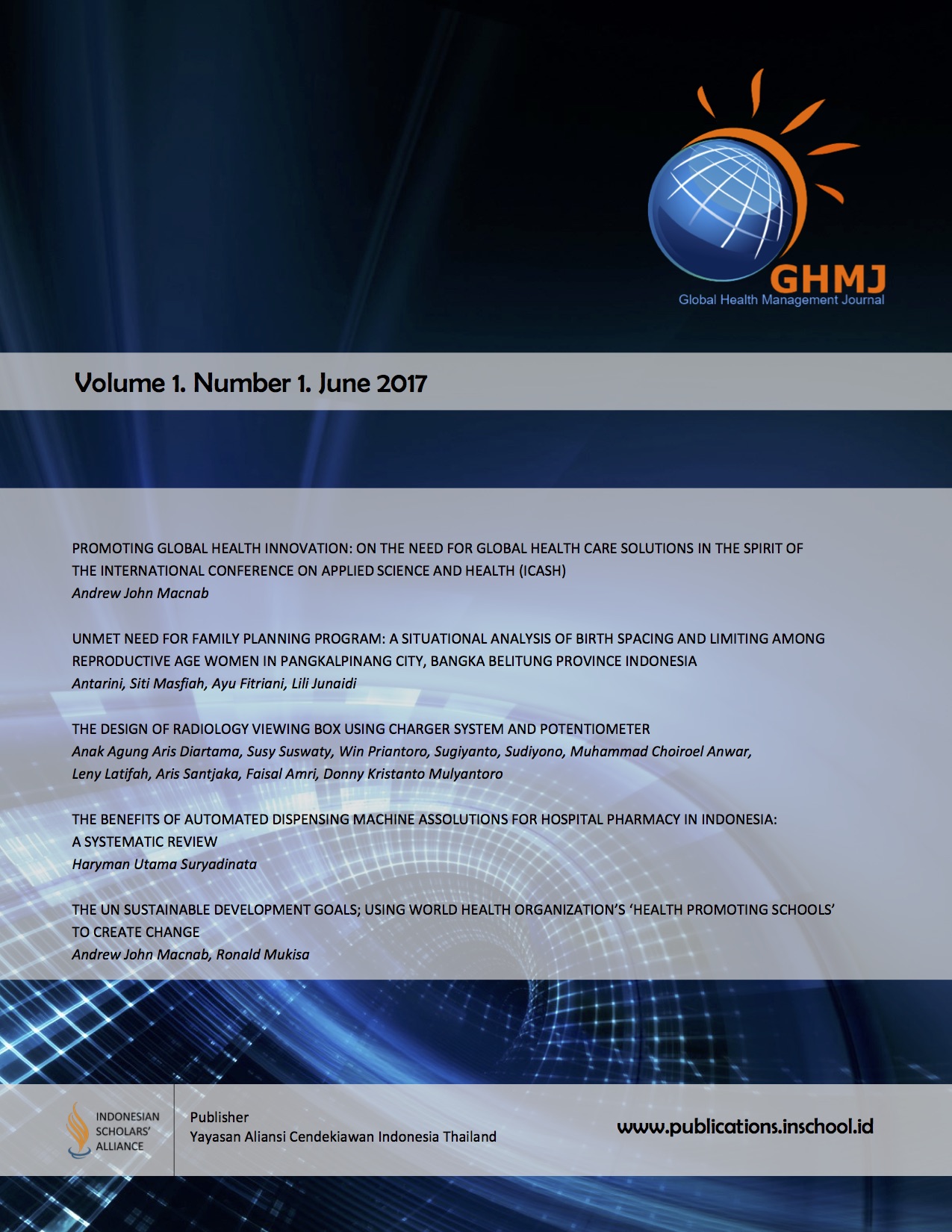The UN Sustainable Development Goals; using WHO ‘Health Promoting Schools' to create change.
DOI:
https://doi.org/10.35898/ghmj-1190Abstract
Accepted: 23 May 2017. Published: 22 June 2017.
Abstract is not required for photo essay. Below are the summary and keywords the journal provides for insight to our reader.
Summary: The article highlights the global epidemiological significance of the United Nations Sustainable Development Goals (SDGs), particularly in addressing poverty. It proposes an innovative approach using the World Health Organization's (WHO) Health Promoting School (HPS) model to address factors affecting children's health and well-being. The HPS approach focuses on multi-disciplinary strategies within school communities, aiming to generate lifelong awareness and positive behaviors that influence the social determinants of health. School-based programs, especially in low and middle-income countries, often include activities like planting school gardens, contributing to improved nutrition, academic achievement, and skill development. The article emphasizes the relevance of these initiatives to specific SDGs (1-6) and underscores the role of schools in reaching a large population to address social determinants of health.
Keywords:
- Sustainable Development Goals (SDGs)
- World Health Organization (WHO)
- Health Promoting School (HPS) model
- Multi-disciplinary strategies
- School-based health promotion
- Social determinants of health
- School gardens
- Nutrition
- Academic achievement
- Skill development
- Low and middle-income countries
- Micronutrients
- Food security
- Sustainable agriculture.
Downloads
References
Armstrong D. A survey of community gardens in upstate New York: Implications for health promotion and community development. Health and Place. 2000; 6:319-327. https://doi.org/10.1016/S1353-8292(00)00013-7
Bundy DA, Shaeffer S, Jukes M. et al. School-based health and nutrition programs. In: Jamison DT, Breman JG, Measham AR, et al. Editors. Disease Control Priorities in Developing Countries. The World Bank, Washington, DC, 2nd edition. 2006; pp 1091-1108. https://doi.org/10.1596/978-0-8213-6179-5/Chpt-58
Commission on Social Determinants of Health. Closing the gap in a generation: health equity through action on the social determinants of health: final report of the commission on social determinants of health. World Health Organization, Geneva. 2008.
Hotz C, Loechl C, de Brauw A et al. A large-scale intervention to introduce orange sweet potato in rural Mozambique increases vitamin A intakes among children and women. British Journal of Nutrition. 2012; 108(01): 163-76. https://doi.org/10.1017/S0007114511005174
Kirby D, Obasi A, Laris B. The effectiveness of sex education and HIV education interventions in schools in developing countries. WHO Technical Report Series. 2006: 938:103-150.
Knai C, Pomerleau J, Lock K, McKee M. Getting children to eat more fruit and vegetables: a systematic review. Preventive Medicine, 2006; 42(2): 85-95. https://doi.org/10.1016/j.ypmed.2005.11.012
Kwan SYL, Petersen PE, Pine CM, Orutta A. Health-promoting schools: an opportunity for oral health promotion. Bulletin World Health Organization 2005; 83(10):1590/S0042-96862005000900013
Low JW, Arimond M, Osman N, Cunguara B, Zano F, Tschirley D. A food-based approach introducing orange-fleshed sweet potatoes increased vitamin A intake and serum retinol concentrations in young children in rural Mozambique. The Journal of Nutrition. 2007; 137(5): 1320-7. https://doi.org/10.1093/jn/137.5.1320
Macnab AJ, Gagnon F, Stewart, D. Health Promoting Schools: Consensus, challenges and potential. Health Education. 2014; 114(3):170-185. https://doi.org/10.1108/HE-11-2013-0055
Macnab AJ, Kasangaki A. 'Many voices, one song': a model for an oral health programme as a first step in establishing a health promoting school. Health Promotion International. 2012; 27(1): 63-73, doi: 10.1093/heapro/dar039. https://doi.org/10.1093/heapro/dar039
Macnab AJ. Mukisa R, Mutabazi S, Steed R. Malaria in Uganda: school-based rapid diagnostic testing and treatment. Int J Epidemiology 2016; doi: 10.1093/ije/dyw262. https://doi.org/10.1093/ije/dyw262
Marmot M, Friel S, Bell R, Houweling TA, Taylor S, and Commission on Social Determinants of Health. Closing the gap in a generation: health equity through action on the social determinants of health. The Lancet. 2008; 372(9650): 1661-1669. https://doi.org/10.1016/S0140-6736(08)61690-6
Migele J, Ombeki S, Ayalo M, Biggerstaff M. Diarrhea prevention in Kenyan school through the use of simple safe water and hygiene intervention. American Journal of Hygiene and Tropical Medicine. 2007; 76: 351-353. https://doi.org/10.4269/ajtmh.2007.76.351
Miguel E, Kremer M. Worms: identifying impacts on education and health in the presence of treatment externalities. Econometrica. 2004; 72(1): 159-217. https://doi.org/10.1111/j.1468-0262.2004.00481.x
Mukisa R, Macnab AJ, Mutabazi S, Steed R. Teachers as agents of change: school-based diagnosis of malaria positively impacts child morbidity. Proceedings of the International Conference on Applied Science and Health. 2017; 93-102. https://publications.inschool.id/index.php/icash/article/view/818
Paul-Ebhohimhen VA, Poobalan A, van Teijlingen ER. A systematic review of school-based sexual health interventions to prevent STI/HIV in sub-Saharan Africa. BMC Public Health 2008; 8(4) doi:10.1186/1471-2458-8-4. https://doi.org/10.1186/1471-2458-8-4
Pérez-Rodrigo C, Aranceta J. School-based nutrition education: lessons learned and new perspectives. Public Health Nutrition. 2001; 4(1a): 131-9. https://doi.org/10.1079/PHN2000108
Royal Horticultural Society. Food growing in schools taskforce report. 2012 pp. 1-66. http://www.gardenorganic.org.uk
Tang K, Nutbeam D, Aldinger C et al. Schools for health, education and development: a call for action. Health Promotion International. 2008; 24(1):68-77. https://doi.org/10.1093/heapro/dan037
Viner RM, Ozer EM, Denny S et al. Adolescence and the social determinants of health. The Lancet. 2012; 379(9826):1641-52. https://doi.org/10.1016/S0140-6736(12)60149-4
West P, Sweeting P, Leyland A. School effects on pupil's health behaviours: evidence in support of health promoting school. Research Papers in Education. 2004; 19(30): 261-292. https://doi.org/10.1080/02671522.2004.10058645
WHO. Global Prevalence of Vitamin A Deficiency in Populations at Risk 1995-2005. WHO Global Database on Vitamin A deficiency. Geneva: World Health Organization. 2009
WHO. Vitamin A deficiency | Micronutrient deficiencies http://www.who.int/nutrition/topics/vad/en/ (Accessed March 20 2017)
World Health Organization (2013). What is a health promoting school? http://who.int/school_youth_health/gshi/hps/en/index.html. (Accessed September 10 2016)
www.un.org/sustainabledevelopment/sustainable-development-goals (Accessed September 10 2016)
Downloads
Published
Issue
Section
Categories
License
Copyright (c) 2017 Andrew John Macnab, Ronald Mukisa

This work is licensed under a Creative Commons Attribution-NonCommercial-ShareAlike 4.0 International License.
GHMJ (Global Health Management Journal) conforms fully to The Budapest Open Access Initiative (BOAI) and DOAJ Open Access Definition. Authors, readers, and reviewers are free to Share ” copy and redistribute the material in any medium or format, and Adapt ” remix, transform, and build upon the material. Author(s) retain unrestricted copyrights and publishing rights of their work. The licensor cannot revoke these freedoms as long as you follow the license terms. Learn the details at the License policy.





















